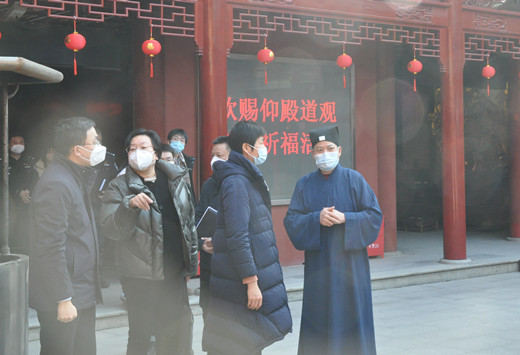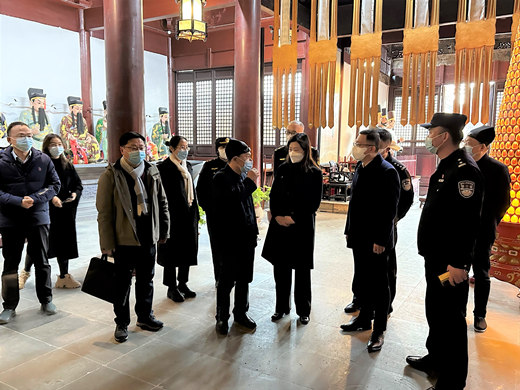New agents and new ethos of Daoism in China today(4)
江南app下载-官方网站Yang Der-Ruey
2015-10-20
The emergence of this network is actually a part and parcel of the process through which the Watergate Mazu Temple was built. So, let’s be gins with the historical background of this temple. Wudu used to be one of the most reputable centers of monastic Daoism in China for more than a thousand years until the mid-Ming Dynasty. However, since the advent of the Qing Dynasty , the influence of Daoism in Wudu evaporated speedily. As a result, while Daois m has been revived vibrantly in many neighboring cities or counties since the late 1990s, there was no known attempt to rebuild a Daoist temple or to organize a Daoist association in Wudu. The situation began to change in 2004 when the Bureau of Tourism of Wudu decided to restore an ancient Mazu Temple nearby the city’s historic dockland and make the “Dockland Mazu Temple” a tourist attraction. The temple was thus restored and opened to the public in 2005. Unfortunately, this investment turned out to be literally an embarrassment for the Bureau. Despite the huge crowd attracted by its opening ceremony (some 200,000 people according to the police’s record), theDockland Mazu Temple fail ed to attract tourists or pilgrims afterward. Then, there came a rumor saying that the Tourist Bureau resolutely rejected a proposal about handing the temple’s management to the Bureau of Religious Affairs, which virtually implies that the temple willbecome a real Daoisttemple run by priests. Whether this anecdote is true or not, the temple is nevertheless still controlled by the Tourist Bureau and run by several fake Buddhist monks who are actually cheap labors hired by the Tourist Bureau on temporary basis. Now, there is virtually no religious activity being conducted in the temple except the ann ual “temple festival” for celebrating the birthday of Mazu.
The failure of the Dockland Mazu Temple disappointed many “hidd en” sympathizers and devotees of Daoism in Wudu, including some sen ior advisors of the Bureau of Cultural Heritage Preservation who specialize on traditional Chinese arts and crafts, especially on the renovation of ancient buildings and repairing artworks. Hence, these senior advisors began to l obby for the restoration project of another temple – the Watergate Mazu Temp le. Having witnessed the failure of the Dockland Mazu Temple, they formed a strategy to keepaway the negative influence of the Tourist Bureau – to regi ster the Watergate Mazu Temple as a “city-level cultural heritage” instead of a tourist site or religious site and then insert this project into the higher-level project for converting the entire neighborhood sur rounding the Watergate Mazu Temple into a “historic/cultural neighborhood”, which is in turn a part of the Wudu City’s “Eleventh Five-Year Social Economic Development Plan”. Their proposal was soon approved by the municipal government. Not long after that, in 2006, they then successfull y acquired a huge donation for the restoration project from the owner of one of the biggest porcelain producers in China. Based on this pledge, they then m obilized their personal connections in various offices of the municipal govern ment and CCP committee of Wuduto raise fund and resolve all kinds of trouble that have happened throughout the construction process. In the end, the t itles of all the offices that have ever involved in this project, whether by offering fund or offering help, were inscribed on a stone tablet standing in front of the main hall of the temple. It is really a surprise as well as an amusement to see the title of the Bureau of Public Security, the chief prose cutor of all kinds of “superstition” during the past, and the impressive amo unt of donation it contributed is inscribed on the head position follo wed by a long list of governmental and CCP’s units along with some large comp anies or rich businessmen.
The network of political and financial patrons has put all the needed resources and political support in place for the temple’s buildings and its legal status, so the next pressing issue would be to find out t he proper persons to supervise the construction, set up the interior, and run the temple. It is at this point then the network of Daoist priests came to joi n the Watergate Mazu Temple’s network. To be brief: when the construction work has gotten on its track, the champions of this restoration project in the Bureau of Cultural Heritage Preservation began to look for suitable Daois t priests. Then, someone in the Bureau of Religious Affairs responded their requ est by contacting an old-time friend of his, arenowned senior Quanzhen Daoist master in a temple nearby the Wudang Mountain, and asked the latter to recommend suitable candidates. Consequently, the senior master sent a matured disciple of his, Mr. Wu, to be the head priest of the forthcoming temple . Having accepted this assignment, Mr. Wu then mobilized his connection with his old-time fellow disciples, who had dispersed to all over China after their grad uation and have gradually become leaders of smaller temples, to look for suitable partners for this new job. Eventually, the temple was opened to the publ ic at the end of 2008as a genuine Daoist temple run by a group of four Quanzh en Daoist priests come from Hubei, Shanxi, and Jilin.
The decision of the Bureau of Religious Affairs to ask the reno wned Quanzhen Daoist master in the Wudang Mountain to recommend candidates, which leads to the nomination of Mr. Wu and his assistants, is actually a very bold and novel idea if we take the local situation into account. To appreciate the delicacy of this decision, we should firstly acknowledge that Wudu and virtually the entire Jiangsu Province has always been the terri tory of Zhengyi Daoism ever since this denomination was found in the 13th century. Although the Quanzhen did successfully establish some bridgeheads in thi s region especially during the recent two centuries, its influence is ne vertheless still much lesser than Zhengyi Daoism. Therefore, the hegemony of Zhengyi clergy in the Daoist Association of Jiangsu has since been unch allengeable. Moreover, Wudu is very close to one of the three most precious sacred mountains for Zhengyi Daoism – Mao Mountain – and so all the “dispersed dwelling Daoist priests” working in the adjacent suburban and rural area practice some localized, vulgar style of Zhengyi liturgy. So, the decision to nominate Mr. Wu as the leader of Watergate Mazu Temple is no less than estab lishing an enclave of Quanzhen Daoism amidst the heartland of Zhengyi Daoism.
Due to the limit of space, we cannot give an adequate explanation for the reason why the Bureau of Religious Affairs made this decision. After all, what concerns our topic here is rather the result of this decision t o channel in a network of “foreign” Quanzhen Daoist priests. The most apparent result is that neither the Watergate Mazu Temple as a unit nor the members of its crew as individual Daoist priests joined any Daoist association . In fact, both the Bureau of Religious Affairs and the crew of the Watergate Mazu Temple did not want to take the hassle to establish a Wudu Daoist Associat ion because, basically, there is only one small temple with four temple-dwel ling priests in the urban area of Wudu, which is less than the minimum requi rement for initiating a local Daoist association. Meanwhile, the higher-le vel Daoist Association, i.e. the provincial Daoist Association of Jiangsu, is controlled by Zhengyi clergy and so it’s very unlikely for them to provide any meaningful help to this newly found enclave of Quanzhen Daoism. Hence, bas ed on the tacit agreement between the Bureau of Religious Affairs of Wudu and M r. Wu, the Watergate Mazu Temple is still independent from the establishme nt of officially recognized Daoism until today despite the fact that it has been a fully functioning temple for years.


 |
|










 京公网安备 11010202006208号
京公网安备 11010202006208号